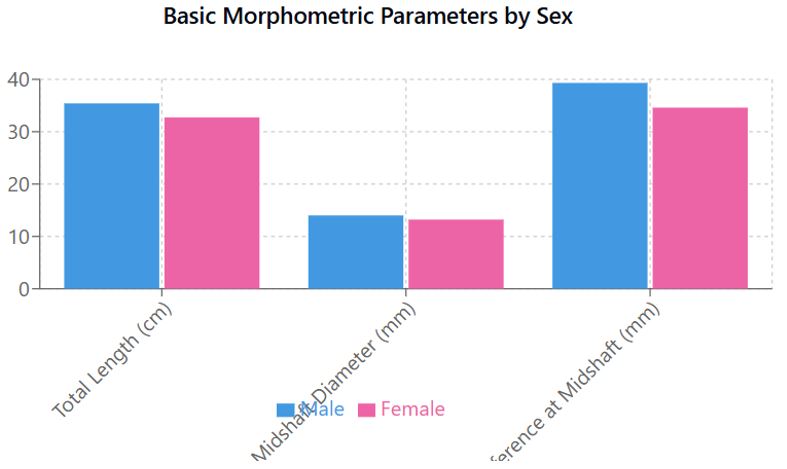A Study Of The Diaphyseal Nutrient Foramina Of Dried Bangladeshi Fibulae
Abstract
Context: The fibula serves crucial functions in lower limb biomechanics and is frequently used in reconstructive surgery. Understanding its nutrient foraminal patterns is essential for surgical success and forensic applications. However, population-specific data for Bangladeshi fibulae has been lacking.
Objectives: To determine the morphometric characteristics of diaphyseal nutrient foramina in dried Bangladeshi fibulae.
Methods: This cross-sectional analytical study examined 120 dry fully ossified left human fibulae (68 male, 52 female) at Dhaka Medical College. Measurements included total length, diaphyseal dimensions, nutrient foraminal characteristics (number, position, direction), and talar facet parameters. Sexual dimorphism was assessed using unpaired Student's t-test and chi-square test.
Results: Significant sexual dimorphism was observed in total length (male: 35.41 ± 1.67 cm, female: 32.72 ± 1.28 cm, p<0.001), midshaft diameter (male: 14.01 ± 1.07 mm, female: 13.21 ± 0.85 mm, p<0.001), and nutrient foraminal measurements. Single nutrient foramen predominated in both sexes (male: 95.6%, female: 92.3%), with primarily downward direction (male: 95.6%, female: 100%). Type-2 Foraminal Index was most common (male: 98.5%, female: 98.1%). Nutrient foramina were predominantly located on the posterior surface in males (42.6%) and medial crest in females (32.7%).
Conclusion: This study establishes baseline morphometric data for Bangladeshi fibulae, demonstrating significant sexual dimorphism and consistent nutrient foraminal patterns. These findings have immediate applications in surgical planning, particularly for fibular grafting procedures, and provide valuable reference data for forensic sex determination in the Bangladeshi population.
Downloads
References
2. Fasemore MD, Bidmos MA, Mokoena P, Imam A, Billings BK, Mazengenya P. Dimensions around the nutrient foramina of the tibia and fibula in the estimation of sex. Forensic Sci Int 2018;287:222e1-7.
3. Gumusburun E, Yucel F, Ozkan Y, Akgun Z. A study of the nutrient foramina of lower limb long bones. Surg Radiol Anat 1996;18(3):199-203.
4. Hamzehtofigh M, Rahimi M, Bayat P. Evaluation of Nutrient Foramen of the Femur, Tibia and Fibula Bones in Center of Iran. Iran J Orthop Surg 2018;16(2):238-243.
5. Ioannidis T, Karamitros A, Gadaifis N, Korres D. A unique case of a four-level fracture of the fibula. Eur J Orthop Surg Traumatol 2004;14:47-49.
6. Kollner MG, Bleck K. Exploratory evidence of sex-dimorphic associations of the Ulna-to-Fibula Ratio. Adapt Human Behav Physiol 2020;6:93-118.
7. Lingamdenne PE. Evaluation of osteometric parameters of fibula and talar facet morphometry in Telangana region. Indian J Clin Anat Physiol 2019;6(4):497-502.
8. Maccurdy GG. International Congress of Prehistoric Anthropology and Archeology, Geneva. Am Anthropol 1912;14(4):621-631.
9. Majid H, Ali HSMY, Ejaz R, Athar T, Bukhari MH, Shahid S. Study of the Anatomical Variations in the Nutrient Foramina of Fibula. Ann Punjab Med Coll 2020;14(1):37-39.
10. Mazengenya P, Billings B. Topographic and morphometric features of the nutrient foramina of the fibula in the South African mixed-ancestry population group and their surgical relevance. Eur J Anat 2016:329-336.
11. Mazengenya P, Fasemore MD. Morphometric studies of the nutrient foramen in lower limb long bones of adult black and white South Africans. Eur J Anat 2015;19(2):155-163.
12. Mohan K, Devaraj B, Ramanathan S, Rethinasamy M. Morphometric study of nutrient foramen in the long bones of lower limb. Int J Anat Res 2017;5(2):3943-3948.
13. Moore KL, Dalley AF, Agur AMR. Clinically Oriented Anatomy. 7th ed. Philadelphia: Lippincott Williams & Wilkins; 2014.
14. Murlimanju BV, Prashanth KU, Prabhu LV, Chettiar GK, Pai MM, Dhananjaya KVN. Morphological and topographical anatomy of nutrient foramina in the lower limb long bones and its clinical importance. Australas Med J 2011;4(10):530-537.
15. Ongeti KW, Obimbo MM, Bundi PK, Ogeng'o J. Anatomical variation of position and location of the fibula nutrient foramen in adult Kenyans. East African Orthop J 2007;1(1):16-18.
16. Rao SV, Kothapalli J. The Diaphyseal nutrient foramina architecture- a study on the human upper and lower limb long bones. IOSR J Pharm Biol Sci 2014;9(1):36-41.
17. Raza HKT, Raza SMG, Upadhyay S. Anthropometry of the lateral malleolus. Int J Recent Sci Res 2015;6(6):4821-4826.
18. Sinha P, Mishra SR, Kumar P, Gaharwar A, Sushobhana. Morphology and topography of nutrient foramina in fibula. Ann Int Med Dent Res 2016;2(6):7-12.
19. Snell RS. Clinical Anatomy by Regions. 9th ed. Philadelphia: Lippincott Williams & Wilkins; 2012.
20. Tubbs RS. Pelvic girdle and lower limb. In: Standring S, editor. Gray's Anatomy: The Anatomical Basis of Clinical Practice. 41st ed. London: Elsevier; 2016. p.1405.
21. Vedapriya KA, Rajasree TK. Determination of sex based on adult fibula. Int J Biol Med Res 2013;4(2):3199-3209.
22. Zahra SU, Kervancioglu P, Bahsi I. Morphological and topographical anatomy of nutrient foramen in the lower limb long bones. Eur J Ther 2018;24(1):36-43.

Copyright (c) 2024 Author (s). Published by Siddharth Health Research and Social Welfare Society

This work is licensed under a Creative Commons Attribution 4.0 International License.


 OAI - Open Archives Initiative
OAI - Open Archives Initiative


